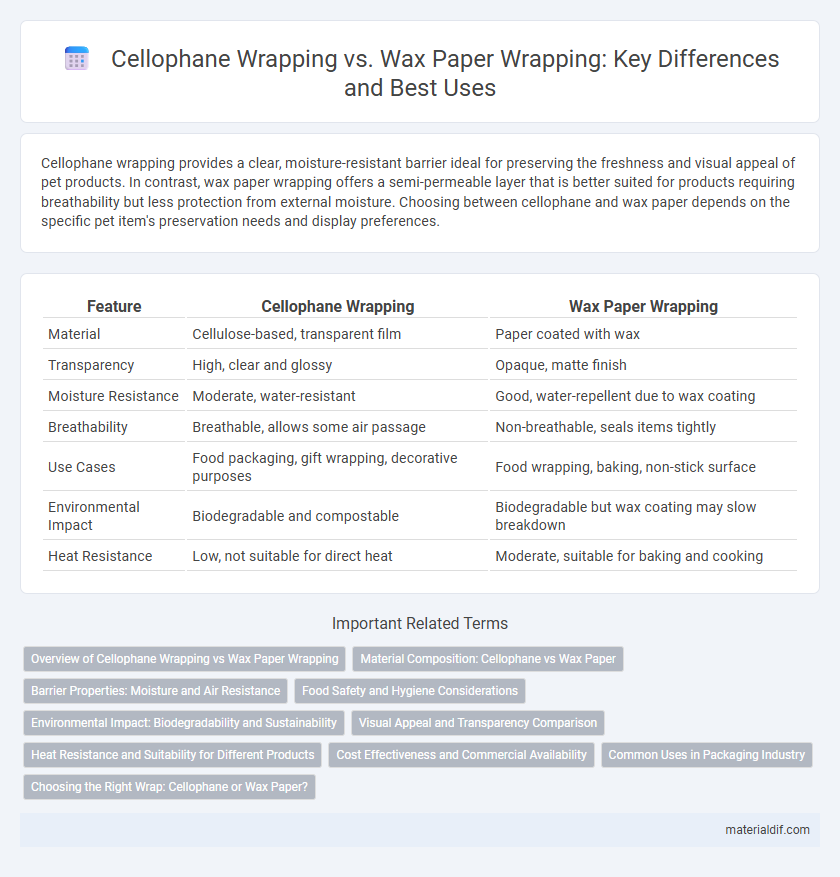Cellophane wrapping provides a clear, moisture-resistant barrier ideal for preserving the freshness and visual appeal of pet products. In contrast, wax paper wrapping offers a semi-permeable layer that is better suited for products requiring breathability but less protection from external moisture. Choosing between cellophane and wax paper depends on the specific pet item's preservation needs and display preferences.
Table of Comparison
| Feature | Cellophane Wrapping | Wax Paper Wrapping |
|---|---|---|
| Material | Cellulose-based, transparent film | Paper coated with wax |
| Transparency | High, clear and glossy | Opaque, matte finish |
| Moisture Resistance | Moderate, water-resistant | Good, water-repellent due to wax coating |
| Breathability | Breathable, allows some air passage | Non-breathable, seals items tightly |
| Use Cases | Food packaging, gift wrapping, decorative purposes | Food wrapping, baking, non-stick surface |
| Environmental Impact | Biodegradable and compostable | Biodegradable but wax coating may slow breakdown |
| Heat Resistance | Low, not suitable for direct heat | Moderate, suitable for baking and cooking |
Overview of Cellophane Wrapping vs Wax Paper Wrapping
Cellophane wrapping offers a transparent, breathable barrier ideal for preserving freshness without trapping moisture, making it suitable for delicate food items and gift packaging. Wax paper wrapping provides a moisture-resistant, non-transparent layer that prevents sticking and is commonly used for wrapping greasy or wet foods. Both materials serve distinct purposes based on their permeability and moisture resistance properties, influencing their effectiveness in food preservation and presentation.
Material Composition: Cellophane vs Wax Paper
Cellophane is made from regenerated cellulose derived from wood pulp or cotton fibers, offering a transparent, biodegradable, and moisture-resistant wrapping material. Wax paper consists of paper coated with paraffin or microcrystalline wax, providing water resistance but lacking transparency and biodegradability. The cellulose base of cellophane allows for breathability and an eco-friendly profile compared to the petroleum-based wax coating in wax paper.
Barrier Properties: Moisture and Air Resistance
Cellophane wrapping offers superior moisture and air resistance compared to wax paper wrapping, making it highly effective for preserving food freshness and preventing contamination. The dense, non-porous structure of cellophane creates an excellent barrier against water vapor and oxygen transmission. Wax paper's coating provides moderate moisture resistance but is considerably less effective at inhibiting air permeability, resulting in shorter shelf life for packaged products.
Food Safety and Hygiene Considerations
Cellophane wrapping provides superior breathability and moisture resistance, reducing the risk of mold growth and bacterial contamination compared to wax paper wrapping. Its natural cellulose composition ensures a non-toxic barrier that does not leach chemicals into food, enhancing overall food safety and hygiene. Wax paper, often coated with paraffin, is less effective at preventing moisture transfer, which can compromise freshness and increase potential for microbial development.
Environmental Impact: Biodegradability and Sustainability
Cellophane wrapping, made from cellulose derived from wood pulp, is biodegradable and compostable, breaking down naturally in weeks under proper conditions. Wax paper wrapping, coated with paraffin wax, is less environmentally friendly as paraffin is a petroleum byproduct that hinders biodegradability and contributes to landfill accumulation. Choosing cellophane supports sustainability goals by reducing plastic waste and promoting decomposition, whereas wax paper's petroleum base presents challenges for eco-conscious disposal.
Visual Appeal and Transparency Comparison
Cellophane wrapping offers superior visual appeal due to its high transparency, allowing the contents to be clearly visible and enhancing product presentation. In contrast, wax paper wrapping is opaque and lacks clarity, which can obscure the product and reduce visual attractiveness. The transparent nature of cellophane makes it ideal for showcasing items, while wax paper is primarily used for protection rather than display.
Heat Resistance and Suitability for Different Products
Cellophane wrapping offers moderate heat resistance, making it suitable for packaging dry goods, bakery items, and fresh produce where breathability and visibility are essential. Wax paper wrapping provides higher heat resistance and moisture barrier properties, ideal for wrapping greasy or warm foods like sandwiches and baked goods with oils. Selecting between cellophane and wax paper depends on product moisture content and temperature exposure during storage or transport to maintain freshness and prevent sogginess.
Cost Effectiveness and Commercial Availability
Cellophane wrapping is generally more cost-effective due to its lower production costs and widespread commercial availability across packaging suppliers and retail stores. Wax paper wrapping tends to be pricier and less commonly stocked in bulk, limiting its cost efficiency for large-scale commercial use. The durability and clarity of cellophane also enhance its appeal for businesses prioritizing attractive, economical packaging solutions.
Common Uses in Packaging Industry
Cellophane wrapping is widely used in the packaging industry for its transparent, moisture-resistant, and biodegradable properties, making it ideal for food packaging such as bakery items, fresh produce, and confectionery. Wax paper wrapping provides a moisture-resistant barrier but is primarily used for short-term wrapping or lining due to its less transparent nature and limited durability. Both materials serve distinct functions: cellophane excels in product visibility and shelf appeal, while wax paper is favored for grease resistance and ease of use in food service.
Choosing the Right Wrap: Cellophane or Wax Paper?
Cellophane wrapping offers superior moisture resistance and clarity, making it ideal for showcasing products while maintaining freshness. Wax paper wrapping excels in grease resistance and non-stick properties, suitable for food items that release oils or require easy unwrapping. Choosing between cellophane or wax paper depends on product protection needs, visual presentation, and whether moisture barrier or grease resistance is the priority.
Cellophane Wrapping vs Wax Paper Wrapping Infographic

 materialdif.com
materialdif.com